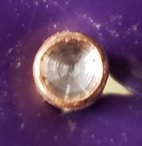OP, a while back there was a suggestion from one of the posters to POWDER COAT undersize bullets being used in a 303Brit.
I scoffed at the idea, at first, but the more I thought about it, the more I became intrigued.
So, I took out one of my No4 Lee Enfield rifles, which shoots .311-.312 diameter bullets very well. It will shoot just about any of the older open base bullets well, no matter the diameter, even if they are as small as .308.
I have tried to shoot .310 diameter, appx 150 grain Soviet surplus ball through this rifle (solid base) and the best it would shoot was 10 inches (21cm) at 100yds.
It only takes a couple of minutes to put a teaspoon full of powder and acetone into a jar and add some bullets to shake up.
I had twenty of the surplus bullets on hand, so I coated them and put them into the oven. Lovely blue bullets were the result.
Loaded them into cases which were set aside for this rifle, with the charge of IMR3031 it prefers, and took it to the range for early morning shooting.
It still didn't shoot as well as the larger uncoated bullets but at our 100yd range, it shot all 20 rounds into a decent sub 4 moa group.
I don't believe the powder coating will ever become a tack driver and maybe tweaking the powder a bit by reducing its amount, might make it better, but I'm not desperate for bullets and I don't like pulling down my ever-dwindling supply of 7.62x54R, so that's where it will stop for me.
It may or may not work in your rifle.








































































